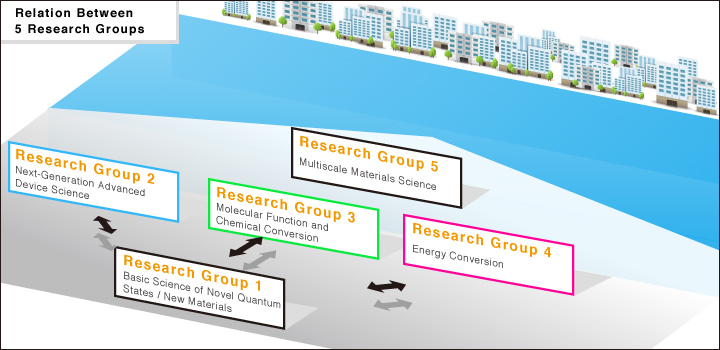Research Activities
In the development of materials science, the role played by computer simulations is as important as that of theory and experiments. In the computational materials science, there are several simulation methods that have different degrees of accuracy and computational complexity, depending on whether the system is treated as a quantum system, classical system, or continuum system, etc. New paradigms are expected to result from further development and appropriate combination of these methods.
CMSI has established the following research groups in order to actively carry out this type of research. The research groups are pursuing close mutual interchange with one another.

Research Group 1: Basic Science of Novel Quantum States / New Materials
New materials with novel properties have been discovered in recent years, including high-temperature superconductors (materials with zero electrical resistance) produced through iron and copper oxides, topological insulators (insulators in which only the surface exhibits metallic conduction), and fullerene and other nanocarbon materials.
This research group will determine the mechanism by which the functions of these new materials are manifested within the context of materials science, and will work to improve and establish more precise calculation methods (the Monte Carlo method, the MP2-F12 method and so on).
- Priority Research Topic: Search for new quantum phases in strongly-correlated quantum systems and explanation of dynamics
- Priority Research Topic: Electron states and dynamics: new developments in molecular theory and integration of heat fluctuations
Research Group 2: Next-Generation Advanced Device Science
The thin wire technologies for the semiconductors that control the performance of today's electronic devices are approaching the limit of their effectiveness. This research group will work to achieve a fuller understanding of the behavior of optical devices (components that use light in place of electrical signals), which have attracted considerable attention as a next-generation technology, as well as silicon nanowires (fine silicon wires measuring several nanometers in diameter) in an effort to achieve practical applications for these technologies.
- Priority Research Topic: Prediction of electron functions in nanostructures using the density functional approach
Research Group 3: Molecular Function and Chemical Conversion
This research group will treat biomolecules as materials in an effort to understand virus propagation/infection and immunological mechanisms on the molecular level. Based on the knowledge achieved through this research, simulations will be conducted for the docking of candidate drug materials and the proteins that make up viruses, in order to help in the discovery of new drugs.
- Priority Research Topic: Development of the molecular science of viruses through all-atom simulations
Research Group 4: Energy Conversion
An understanding of electrode chemical reactions is essential in order to discover materials that can provide increased capacity and longer life to the fuel cells and lithiumion batteries that are used in electric vehicles and the like. Moreover, in order to efficiently extract methane from methane hydrate (a compound consisting of methane enclosed by water molecules, which is expected to become an ecological energy source), the process by which methane hydrate forms and dissolves must be understood. This research group will work to elucidate these chemical reaction processes using computer simulations.
- Priority Research Topic: Large-scale calculations for basic processes in fuel-cell related materials
- Priority Research Topic: Mechanism of hydrogen and methane hydrate formation and dissolution and the rmodynamic stability
Research Group 5: Multiscale Materials Science
To increase the toughness of iron and steel materials, an understanding of not only the microscale behavior of electrons and atoms but also their mesoscale internal structure growth is needed since the formation of structures in the coagulation process exerts an effect on the macroscopic properties of the products. This research group will conduct simulations whose goal is smooth linkage on various scales.

